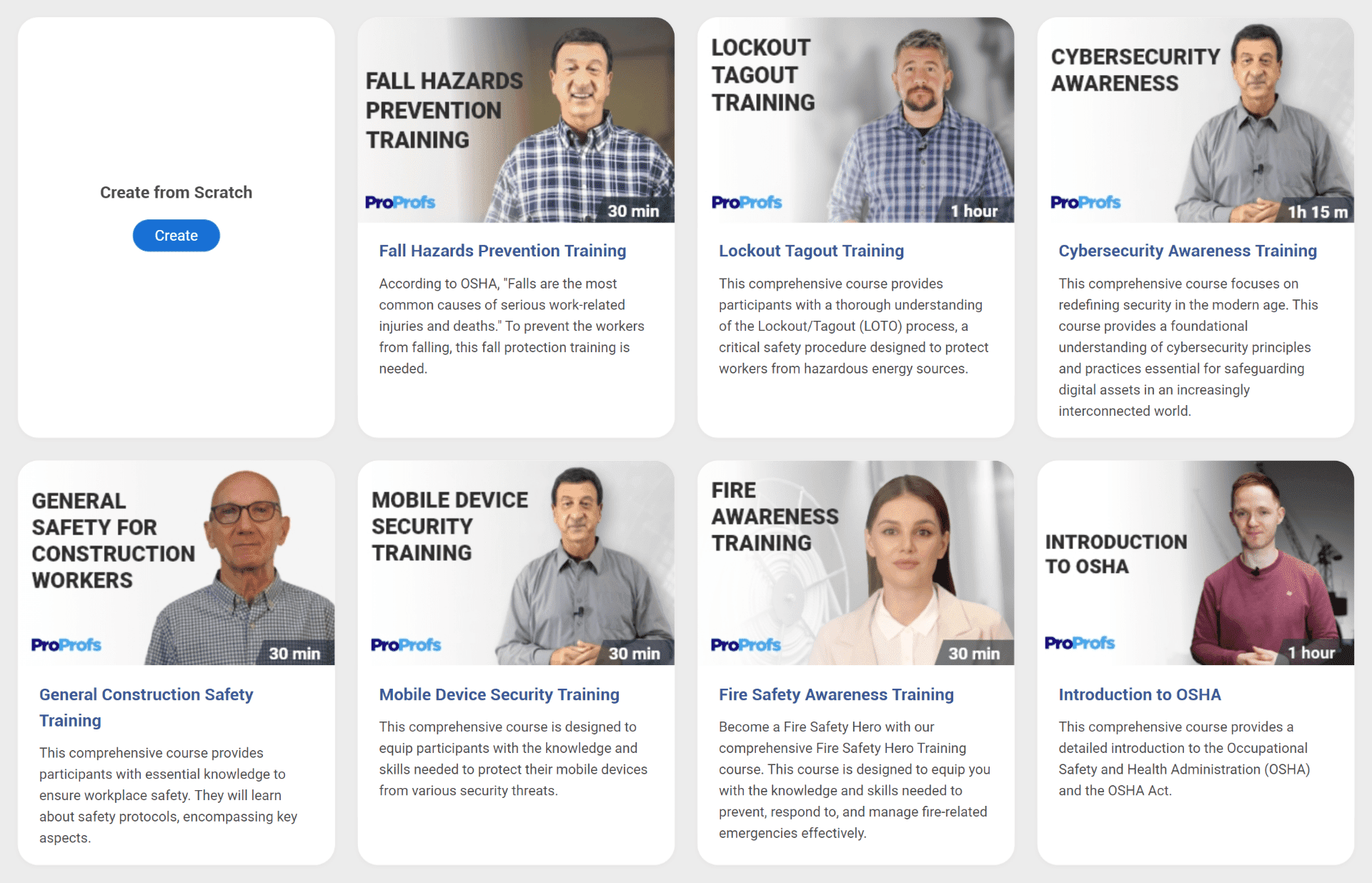
Workplace safety training is vital for keeping supervisors and employees informed about potential hazards and remediation plans in the workplace.
It imparts the necessary knowledge and skills to minimize workplace accidents and injuries, and foster a safety culture that leads to increased productivity and overall operational efficiency.
In this effort, workplace safety training programs and courses can be immensely invaluable.
Here’s a list of such courses and programs you can deploy to ensure long-term safety.
List of Employee Workplace Safety Training Programs
Workplace safety is a subject close to my heart. For the past month, I’ve dedicated myself to countless hours researching and evaluating the best options to come up this list.
I firmly believe that the quality of courses you use in your workplace training programs determines the effectiveness of your learning & development initiatives.
So, let’s explore the top employee safety training courses. Each of these courses is tailored to address specific risks and challenges in your workplace.
1. OSHA Focus Four Injury Prevention Training
OSHA training has been instrumental in improving workplace safety. Since its inception, OSHA and its state partners have had a dramatic effect on workplace safety.
Worker deaths in the U.S. are down—on average, from about 38 worker deaths a day in 1970 to 13 a day in 2020.
Worker injuries and illnesses are also down—from 10.9 incidents per 100 workers in 1972 to 2.7 per 100 in 2020 (source).
I find the OSHA Focus Four Injury Prevention Training to be an essential part of our safety program. This is one of the best workplace safety training topics that cover the four most common causes of fatalities in the construction industry: falls, struck-by objects, electrocutions, and caught-in/between hazards.
The course helps our employees identify, avoid, and protect themselves from these hazards on the job site. It provides practical strategies and information for our workers to stay safe and healthy.
What I appreciate most about this course is its focus on real-world application. The training is not just about learning the rules but understanding why they matter and how to apply them in everyday situations. This makes it a powerful means for fostering a safety culture within our organization.
2. HAZMAT Training for Healthcare Workers
A recent study by the Agency for Toxic Substances and Disease Registry (ATSDR) highlighted the importance of managing clinical chemical exposure, especially in healthcare settings.
This highlights the need for healthcare workers to be well-equipped with the knowledge and skills to handle hazardous materials (HazMat) in their daily work environment.
That’s why I recommend the HazMat Training for Healthcare Workers course. It is an excellent resource for this purpose.
It covers everything your employees need to know about hazardous materials in healthcare, including their types, sources, response plans, individual roles, detection & identification, and waste management.
What sets this course apart is its practical approach. It includes real-life scenarios, handouts, and assessments that not only enhance the learning experience but also ensure that the knowledge gained is applicable to real-world situations.
Moreover, the course is online, making it accessible and convenient for employees. It also comes with a nationally recognized completion certificate, providing tangible proof of employees’ competency in handling hazardous materials.
3. Fall Protection Training
Another safety training for employees that I would recommend is fall protection training because falls are a serious and common hazard in many work settings.
According to statistics, falls are the leading cause of death in construction, accounting for 351 fatalities out of 1,008 in 2020. Even in non-construction settings, falls can cause severe injuries such as broken bones or head trauma. (source)
Therefore, learning how to prevent and protect your employees from falls is important.
This course covers the essential topics and skills related to fall prevention and protection. You can impart knowledge of different types of fall hazards, such as ladders, scaffolds, roofs, and holes, and how to identify and avoid them.
As one of the best workplace safety training programs, it also covers different types of fall protection equipment, such as personal fall arrest systems (PFAS), guardrails, safety nets, and covers, and how to select, use, and maintain them properly.
The best thing I like about this course is that it comes with practical exercises and quizzes to test your learners’ knowledge.
This course will give you valuable information and skills to help you work safely and prevent fall-related injuries and deaths. This course is suitable for anyone who works at heights or near fall hazards, such as construction workers, roofers, painters, window cleaners, and more.
4. Personal Protective Equipment (PPE) Training
In many workplaces, employees are often exposed to various hazards, such as chemicals, dust, noise, heat, radiation, and infectious diseases.
Personal protective equipment (PPE) can help protect workers from these hazards by minimizing exposure.
PPE is not a substitute for other safety measures, such as engineering controls, administrative controls, and safe work practices. However, when other methods are not feasible or effective, PPE should be used as a last resort.
Workers should know how to select, use, maintain, and dispose of PPE properly. This Personal Protective Equipment Training is an online course that covers the basics of PPE, including the types, functions, limitations, and standards of PPE.
This workplace safety training course also teaches workers how to perform a hazard assessment, fit and wear PPE correctly, inspect and care for PPE, and report and replace damaged or defective PPE.
The interactive, engaging, and easy-to-follow safety training for employees includes videos, quizzes, and scenarios to help workers learn and retain the information.

The course is also compliant with the OSHA standards and regulations for PPE. Upon completion of the course, workers will receive a certificate of achievement that they can print or share online.
5. Fire Extinguisher Safety Training
In the United States, employers who fail to provide proper fire extinguisher training to their employees can face serious penalties from the OSHA.
If employers expect their workers to use portable fire extinguishers, they must provide hands-on training in using this equipment.
Employers must also comply with the requirements for the placement, use, maintenance, and testing of portable fire extinguishers.
The maximum penalty for violating these standards is $13,653 per violation.
In some cases, misuse of fire extinguishers can also result in criminal charges, such as vandalism, arson, or assault.
Therefore, employers need to provide effective and engaging fire extinguisher training to their employees.
This Fire Extinguisher Training covers various topics. It is a valuable resource for employers and workers alike. The best part is that you can modify the content based on your requirements. For instance, you can add videos, images, flashcards, assignments, etc.
Fire extinguisher training should cover the basics of fire extinguisher use, such as the types, ratings, and classifications of fire extinguishers. It should also teach workers how to identify fire hazards, select the appropriate fire extinguisher, operate and inspect fire extinguishers, and follow the PASS technique (Pull, Aim, Squeeze, Sweep).
6. Ladder Safety Training
Ladders are common tools in many workplaces, but they can pose serious risks if not properly used.
Falls from ladders account for 20% of fatal and lost work-day injuries in the general industry. Regulatory bodies like OSHA can impose a $7,000 fine for each untrained operator and a $70,000 fine for a willful or repeated violation.
I’ve seen my fair share of ladder accidents when I previously worked as a trainer in one of the construction companies. They’re all preventable, but only if people know how to use ladders safely. That’s when I asked my CEO to implement ladder safety training in the workplace.
This course is comprehensive, engaging, and easy to use. It covers everything you need to know about ladder safety, from choosing the right ladder for the job to using it safely and maintaining it properly.
Your employees can take it at their own pace. And because the course focuses on practical knowledge, your employees can apply what they learn right away.
If you are a training manager or an HR executive, you should include this course in your safety training curriculum.
7. Scaffolding Safety Training
Safeguarding the well-being of the workforce is paramount, and the Scaffold Safety course is an indispensable workplace safety training program in achieving this goal.
This safety training program provides a comprehensive understanding of scaffold safety fundamentals, including various scaffold types, their applications, potential hazards, and effective safety measures.
The course also delves into the legal obligations and standards governing scaffold safety, ensuring that employees not only adhere to safety practices but also comply with regulatory requirements.
A distinguishing feature of this course is its emphasis on practical application. Real-life scenarios and assessments are incorporated to ensure that the acquired knowledge is not merely theoretical but can be effectively applied in real-world situations.
Additionally, the online delivery of the course makes it readily accessible and convenient for employees to pursue.
Upon successful completion, participants receive a recognized certificate, which is tangible evidence of their competency in scaffold safety.
8. Back Injury Prevention Training
Back injuries are a common occurrence, often with serious consequences for both health and productivity.
Back injuries account for over 20% of all workplace injuries in the United States. These injuries can result from lifting heavy objects, twisting, bending, or falling, leading to pain, stiffness, reduced mobility, and even permanent disability.
In my personal experience using ProProfs Training Maker, I found their comprehensive course on back injury prevention to be invaluable.
The course covers everything you need to know, including understanding the spine and back muscles, identifying common causes and risk factors, and learning safe lifting techniques. It also provided simple exercises and ergonomic solutions.
The best part is before you start this course, you’ll get a survey to check if you have any back injury symptoms.
What sets this training apart is its interactive content, flexibility in learning, customization options, and expert support.
I highly recommend the course to protect your back, boost productivity, and create a safer work environment.
9. Preventing Workplace Injuries Training
Workplace injuries can have devastating consequences for both employees and employers. They can lead to lost productivity, increased healthcare costs, and even legal liabilities.
That’s why everyone in the workplace must be aware of potential hazards and take steps to prevent them.
The Preventing Workplace Injuries Training Course addresses a critical concern in today’s workplaces. This course equips you to identify and prevent common hazards, emphasizing the responsibilities of employers and employees in creating a safe environment.
The content covers hazard identification, correction, and injury prevention, providing handouts, relatable scenarios, and final assessments.
With OSHA certifications and extensive experience, instructor Dexter Williams brings expertise to the course.
The course offers a user-friendly, interactive learning experience, making it a valuable resource for safety-conscious professionals seeking to mitigate workplace risks.
10. Fatigue Management Training
Feeling tired and drained at work is a common experience, but it doesn’t have to be a constant struggle.
This comprehensive fatigue management course is your gateway to understanding and effectively managing fatigue, empowering you to reclaim your energy and optimize your performance.
The course offers an invaluable opportunity to understand, tackle, and prevent fatigue-related challenges.
Through this workplace safety training course, you’ll develop a keen awareness of the signs and symptoms of fatigue and its effects on your well-being, productivity, and safety. It delves deep into the roots of fatigue, including sleep quality, stress, workload, lifestyle, and medical conditions, enabling you to pinpoint the causes and address them effectively.
The course takes a personalized approach to training. You can craft a tailored plan to combat and prevent fatigue based on your unique needs and goals. The course includes worksheets, real-world scenarios, and end-of-chapter assessments.
Carolina Greno, a seasoned psychologist and trainer with over 13 years of experience, has meticulously designed this course. Her expertise shines through engaging and interactive content with practical tips and resources.
How to Choose the Best Workplace Safety Training Programs
To choose the best workplace safety training programs, first, figure out what safety rules and skills your workplace needs. Look for courses with clear and helpful content, flexible learning formats, and accreditation.
Choose programs that let employees learn at their own pace and that can be customized to your company’s needs. Make sure the training is interesting and hands-on, with certified instructors leading the way.
Lastly, check if the program gives certificates when employees finish so you can track their progress. This way, you can choose a training program that fits your workplace perfectly.
But now the question is, how can you develop this program?
Well, that’s exactly where ProProfs Training Maker comes in.
The tool offers a user-friendly platform for developing, delivering, tracking, and analyzing courses and quizzes. Using it, you can implement hazard-specific training through customizable online courses, ensuring the content aligns with organizational needs. The reports and analytics feature measures completion rates and provides insights for continuous improvement.
ProProfs Training Maker also supports interactive elements like quizzes and surveys, enhancing engagement.
Empower Your Team with the Best Workplace Safety Training Programs
As someone in the learning & training industry, I’ve witnessed firsthand the impact of workplace safety training.
It’s not just about adhering to regulations; it’s about safeguarding your team and your organization’s future success.
The workplace safety training programs I’ve highlighted here are more than just tick-the-box exercises; they’re the building blocks of a culture that prioritizes safety and well-being.
So, don’t hesitate to give your team the best gift you can: the knowledge and skills they need to work safely and efficiently. Your employees are your greatest strength, and their well-being is priceless. Act now and boost your safety standards with confidence.
Frequently Asked Questions
What is workplace safety training?
Workplace safety training is a legally mandated compliance training program for employees and supervisors. The training aims to encourage safety practices in the workplace and remove instances of laxity, negligence, and oversights that threaten workers with injuries and even fatalities. A safety training program includes fall protection, forklift safety, back injury prevention, data security, and hazardous materials.
The training covers three primary areas:
- How to assess and identify potential workplace hazards
- How to report safety issues to the right authority
- How to manage safety matters to prevent their recurrence
Watch: What Is a Construction Safety Training Program for Workers & Employees?
What topics are typically covered in workplace safety training?
Generally, the training covers various topics that are essential for ensuring a safe and healthy work environment. They include hazard identification and risk assessment, emergency preparedness and response, personal protective equipment, fire safety, electrical safety, ergonomics, and workplace violence prevention. These topics help employees to recognize, avoid, and report potential hazards, as well as to respond effectively in case of emergencies. You can also try out these topics for your safety training programs.
Who should attend workplace safety training?
All employees should receive workplace safety training regardless of their role or position. This includes new hires, existing employees, supervisors, managers, and executives. Each group may have specific training needs based on their job duties and the hazards they encounter in the workplace.
Why is workplace safety training important?
Workplace safety training is important for several reasons. First, it helps to prevent accidents, injuries, and illnesses. When employees are aware of workplace hazards and know how to control them, they are less likely to get hurt. Second, workplace safety training can help to improve productivity. When employees feel safe and healthy, they are more likely to be productive and engaged in their work. Third, workplace safety training can help to reduce costs. Employers can save money on workers’ compensation premiums, medical expenses, and lost productivity by investing in workplace safety training.
What should be included in workplace safety training?
Apart from adding suitable topics to your workplace safety training for employees program, it should incorporate multimedia elements. This could include videos, interactive simulations, and real-life examples to engage learners and make the content more accessible and memorable. Finally, refresher courses and assessments can help reinforce the training and keep safety in employees’ minds. To add multimedia, you can try using this safety training software.
Watch: How to Add Media to Your Online Courses
FREE. All Features. FOREVER!
Try our Forever FREE account with all premium features!







